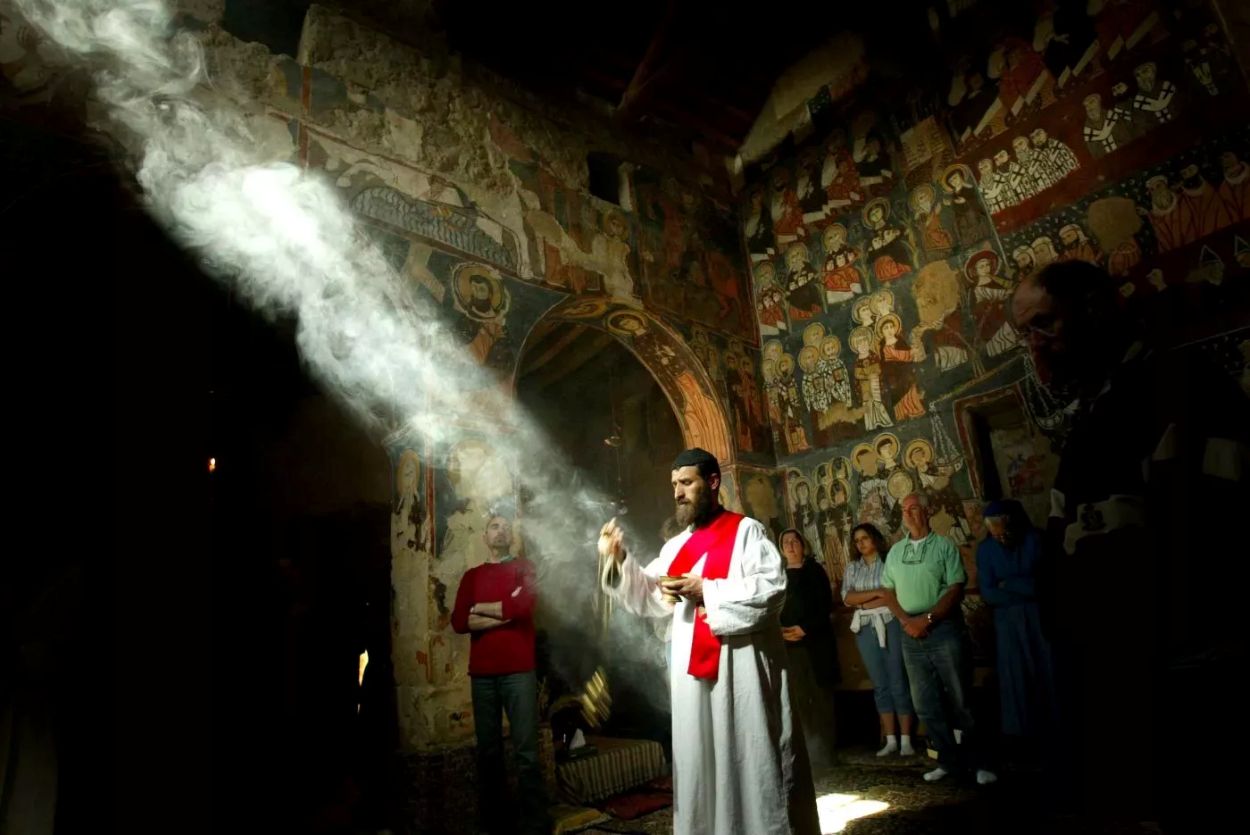The Ancient Hymns of Beth Nahrin: How Syriac Music Articulated Pagan Cosmic Narratives
BETH NAHRIN (SyriacPress) — In his book The Syrians: Ancient and Modern, Syrian author Samir Abdo examines the historical roots of the Syriac people, their Church, and their broader cultural contributions to Arab-Islamic civilization. Among the many facets of Syriac heritage he explores is the music — its origins, evolution, and significance within both the Church and the tradition of the Beth Gazo, a Syriac liturgical book that contains a collection of Syriac chants and melodies.
From antiquity, Syriac music has extended far beyond the realm of entertainment, functioning as a profound spiritual language. It has conveyed cosmic narratives of divine conflict, life and death, and the mysterious forces of nature. In pre-Christian times, it held a central place in pagan rituals, serving as a powerful medium for articulating liturgical meaning and the metaphysical beliefs of the peoples of Beth Nahrin (Mesopotamia) and ancient Syria.
With the rise of Christianity, this expressive and dramatic tradition was not discarded but reinterpreted to accompany new sacred narratives — the life, passion, death, and resurrection of Jesus Christ and His ultimate victory over evil. As a result, Syriac church music developed into a liturgical form that preserved its emotional depth and symbolic power, while adopting a simpler and more transparent structure aligned with Christian worship.
From Liturgical Chants to Choral Ensembles
In its earliest form, the “choir” referred to the collective participation of the faithful in chanting during liturgical services. Gradually, this communal expression evolved into organized, semi-professional choral ensembles, reflecting the increasing musical refinement and devotional depth of the Syriac Christian tradition. Over time, Syriac church music came to exert a notable influence beyond its own religious and cultural sphere. Renowned European composers such as Mozart and Haydn were inspired by the solemnity and structure of liturgical traditions, including those of the Syriac Church, incorporating similar elements into their own sacred compositions.
Mar Ephrem and the Heavenly Melodies
Mar Ephrem the Syrian, revered as the “Harp of the Holy Spirit,” was among the earliest composers of Syriac liturgical hymns. His pioneering contributions laid the foundation for a rich tradition of sacred music, later expanded by other eminent figures in the Christian East. These included Saints Gregory of Nazianzus, Cyril of Jerusalem, John Chrysostom, Mar Isaac, Mar Rabula, Mar Balai and the Potters’ community, Mar Jacob of Serugh, Severus of Antioch, and Jacob of Edessa. Together, they composed enduring hymns and melodies that continue to echo through Syriac churches, shaping the spiritual and artistic landscape of hymnody across generations.

A Living Oral Tradition
One of the defining features of Syriac church music is its enduring vitality as an oral tradition. For centuries, these sacred melodies were transmitted entirely by ear, passed down within churches and prayer communities from one generation to the next. This unwritten legacy remains vibrant today, as Eastern Syriac churches continue to chant these hymns during prayers and supplications.
Although Eastern music is inherently monophonic — built upon a single melodic line — each note in Syriac chant subtly implies an underlying bass tone, creating the sense of an implicit harmonic foundation. This nuanced musical structure, though devoid of formal harmony, lends Syriac music its distinctive depth and resonance, preserving its ancient character while sustaining its spiritual power.
Schools Preserving the Spirit
Several prominent Syriac religious schools have played a crucial role in preserving the spiritual and musical heritage of the Syriac tradition. Institutions such as the School of Dayr al-Za‘faran, the School of Tur Abdin (Mar Gabriel Monastery), and the School of Edessa (Urhoy) served as vital centers for the transmission and performance of Syriac liturgical music. These schools upheld the tradition of chanting and teaching sacred melodies well into the 1970s, ensuring the continuity of their profound spiritual and cultural significance across generations.
Beth Gazo: The Treasury of Spiritual Melodies
The Syriac tradition preserves its vast repertoire of hymns and supplications in a foundational liturgical collection known as Beth Gazo, meaning “Treasury of Melodies.” This anthology serves as a spiritual and cultural archive, encompassing a wide array of sacred compositions. Among its contents are the Madrashe (Ephremic hymns), Takhshefatha (supplications), Mawrbathe (magnifications), Mab‘aranatha (hymns for the departed), and Shubakhe (praises), among others. Together, these hymns form the backbone of Syriac liturgical life, offering a rich tapestry of theological depth, poetic beauty, and devotional expression.
Two Complementary Musical Styles
Syriac church music encompasses two complementary styles. The first is the traditional style, characterized by simple recitation with minimal ornamentation, primarily used in psalmody. This form emphasizes clarity and devotion, preserving the ancient tonal patterns of the liturgy.
The second is a more developed and expressive style, shaped by folk melodies and enriched by the creative contributions of the musical fathers of the Church.
While psalms originally formed the core of Syriac hymnody, the emergence of new texts inspired by the life, passion, and resurrection of Christ led to the development of a broader range of melodies. These reflected renewed spiritual insights and experiences, expanding the emotional and theological depth of Syriac sacred music.
Fairuz: A Modern Echo of Ancient Hymns
A striking modern embodiment of Syriac church music’s enduring influence is found in the work of the renowned Syriac Maronite artist Fairuz. Her performances — particularly those presented during Holy Week, commemorating the Passion, Crucifixion, and Resurrection of Christ — resonate deeply with the Syriac spiritual tradition. Through her voice, ancient hymns are reimagined in a contemporary artistic form, breathing new life into a sacred heritage and bridging past and present with profound emotional and spiritual depth.
A Living Legacy of Faith and Beauty
Syriac church music is far more than an artistic expression. It is a living embodiment of faith, culture, and identity, passed down through generations. Rooted in authenticity and ever open to renewal, it transcends time and space, uniting the earthly and the divine in a single, resonant voice — one that continues to pulse with faith, beauty, and spiritual vitality.





















